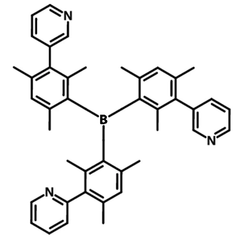3TPYMB
CAS Number 929203-02-1
Electron / Hole Transport Layer Materials, High Purity Sublimed Materials, Host Materials, Semiconducting Molecules, TADF Materials
3TPYMB, an excellent ETL material which allows efficient electron injection
High-purity (>99.0%) and available online for priority dispatch
Tris(2,4,6-trimethyl-3-(pyridin-3-yl)phenyl)borane (known as 3TPYM) is an excellent electron-transport material. With a LUMO energy level of 3.3 eV [1], just lower than most of the work function of cathodes (i.e. CsF/Al), it allows efficient electron injection. This prevents extra electrons from accumulating at the interface.
3TPYMB is also a hole-blocking material with high HOMO of 6.80 eV [1]. This is high enough to block the holes from being recombined with the electrons at the cathode.
3TPYMB has a high triplet-excited energy level (ET = 2.95 eV) [3].
General Information
| CAS number | 929203-02-1 |
|---|---|
| Chemical formula | C42H42BN3 |
| Molecular weight | 599.61 g/mol |
| Absorption* | λmax 331 nm in THF |
| Fluorescence | λem 382 nm in THF |
| HOMO/LUMO | HOMO 6.8 eV, LUMO 3.3 eV |
| Synonyms | Tris(2,4,6-trimethyl-3-(pyridin-3-yl)phenyl)borane, Tri[3-(3-pyridyl)mesityl]borane |
| Classification / Family | Electron-transporting materials, Phosphorescent host materials, Light-emitting diodes, Perovskite solar cells, Organic electronics, TADF materials, Sublimed materials |
* Measurable with an Optical Spectrometer, see our spectrometer application notes.
Product Details
| Purity | Sublimed >99.0% (HPLC) |
|---|---|
| Melting point | TGA: 250 °C (0.5% weight loss) |
| Appearance | White powder/crystals |
*Sublimation is a technique used to obtain ultra pure-grade chemicals, see sublimed materials.
Chemical Structure

Device Structure(s)
| Device structure | ITO/PEDOT:PSS/m-MTDATA*(20 nm)/ m-MTDATA:3TPYMB(60 nm)/3TPYMB(10 nm)/LiF(0.8 nm)/ Al(100 nm) [3] |
|---|---|
| Colour | Red |
| Max. Luminance | 17,100cd/m2 |
| Max. Current Efficiency | 36.79 cd/A |
| Device structure | ITO/EHI608/TCTA/TCTA:3TP:Firpic (1:1:0.17)/3TPYMB/Al [6] |
|---|---|
| Colour | Blue |
| Max Power Efficiency | 27.5 lm W-1 |
| Max. Current Efficiency | 36.0 cd/A |
| Device structure | ITO/MoO3 (1 nm)/TAPC (40 nm)/mCP (10 nm)/DPEPO doped with 2* (12wt%, 20 nm)/3TPYMB (50 nm)/LiF (1 nm)/Al (100 nm) [7] |
|---|---|
| Colour | Blue |
| Max Current Efficiency | 33.5 cd/A |
| Max EQE | 19.7 |
| Max. Power Efficiency | 26.3 lm W-1 |
*For chemical structure information, please refer to the cited references
Pricing
| Grade | Order Code | Quantity | Price |
|---|---|---|---|
| Sublimed (>99.0% purity) | M2088A1 | 100 mg | £180 |
| Sublimed (>99.0% purity) | M2088A1 | 250 mg | £400 |
| Sublimed (>99.0% purity) | M2088A1 | 500 mg | £660 |
MSDS Documentation
Literature and Reviews
- Boosting thin-film perovskite solar cell efficiency through vacuum-deposited sub-nanometer small-molecule electron interfacial layers, W-H. Lee et al., Nano Energy 38, 66–71 (2017); https://doi.org/10.1016/j.nanoen.2017.05.049.
- Organic light-emitting diodes employing efficient reverse intersystem crossing for triplet-to-singlet state conversion, K. Goushi et al., Nat. Photonics 6, 253–258 (2012) doi:10.1038/nphoton.2012.31.
- Novel Electron-transport Material Containing Boron Atom with a High Triplet Excited Energy Level, D. Tanaka et al., Chem. Lett., 36, 262-263 (2007).

 3TPYMB MSDS sheet
3TPYMB MSDS sheet